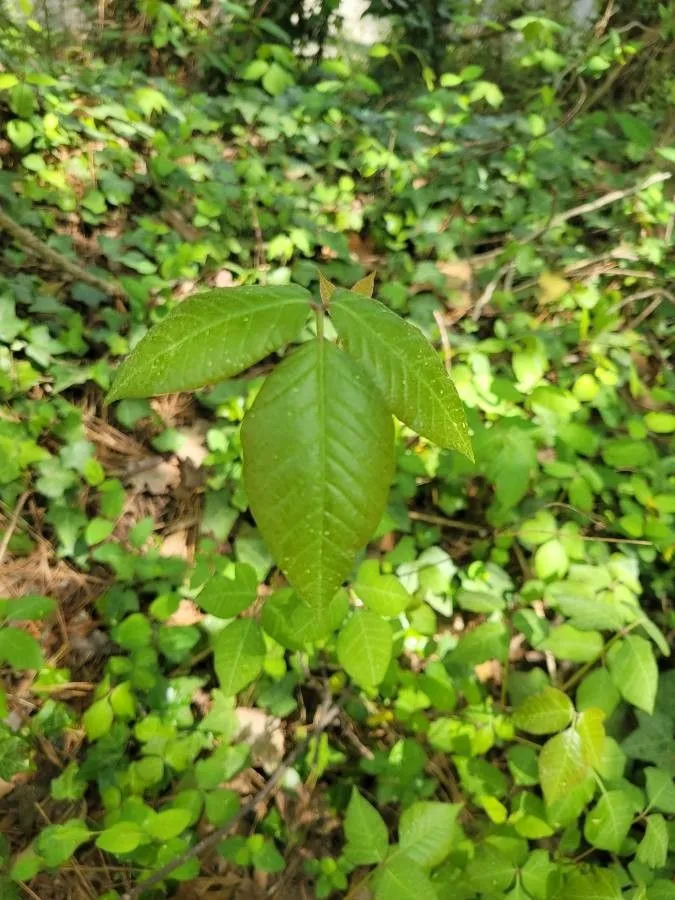
Author: (L.) Kuntze
Bibliography: Revis. Gen. Pl. 1: 153 (1891)
Year: 1891
Status: accepted
Rank: species
Genus: Toxicodendron
Vegetable: False
Observations: E. Canada to Guatemala, Bahamas, Bermuda
Poison-ivy, scientifically known as Toxicodendron radicans, is a notorious plant that belongs to the family Anacardiaceae. Recognized for its toxic properties, this plant demands cautious handling due to the potent irritant, urushiol, found in its sap.
Native to a range extending from Eastern Canada to Guatemala, and also flourishing in the Bahamas and Bermuda, Poison-ivy is a versatile species with a widespread habitat. The plant thrives in various environments, from wooded areas to urban spaces, demonstrating its adaptability and resilience.
Poison-ivy is identifiable by its compound leaves, typically grouping in threes, which has inspired the well-known warning rhyme, “Leaves of three, let it be.” The leaves exhibit a variable morphology, sometimes smooth and other times appearing lobed or toothed, and can range in color from green to red, depending on the season.
The plant flourishes best in areas with full to partial sunlight and is commonly seen climbing trees, walls, and fences using aerial rootlets. In the wild, it often forms a dense ground cover or climbs as a vine, making it a formidable presence in its native regions. Its flowering phase occurs in late spring to early summer, producing small, greenish-white flowers that subsequently develop into whitish, berry-like drupes.
Poison-ivy’s most problematic trait is its production of urushiol, an oily resin that causes severe allergic reactions in most people upon contact. Symptoms can include itching, inflammation, and blistering of the skin, which makes identification and avoidance crucial. Awareness of its appearance and presence is vital for preventing the discomfort and health risks associated with exposure.
Despite its hazardous nature, Poison-ivy plays a role in the ecosystem, providing food for wildlife such as birds and small mammals, which consume its berries without adverse effects. This interaction underscores the complex relationships within natural habitats and the balance between plant defense mechanisms and animal foraging behaviors.
The historical documentation of Poison-ivy, attributed to (L.) Kuntze and revisited in 1891’s “Revis. Gen. Pl. 1: 153,” highlights the plant’s longstanding recognition and study within botanical science. As an entity of both botanical interest and practical concern, Poison-ivy remains a critical subject for education and awareness, ensuring informed interactions with the natural world.
Fra: arbre à la gale, lierre toxique, sumac grimpant, herbe à puce, herbe à la puce, sumac radicant, sumac vénéneux
Eng: eastern poison ivy, poison ivy, poison-ivy
Deu: kletternder giftsumach, kletternder gift-sumach
Ita: sommacco velenoso
Hun: mérges szömörce
Ces: sumach jedovatý, škumpa zákeřná
Swe: klättersumak
En: Poison-ivy, Eastern poison ivy, Eastern poison-ivy; western poison-ivy, POISON IVY, Eastern Poison-ivy, Poison Oak
Am: መርዝ ሐረግ
Ar: سماق سام متجذر
Ca: Heura metzinosa
Zh: 毒漆藤
Hr: Otrovni bršljan
Cs: Jedovatec kořenující, Sumach jedovatý, Škumpa zákeřná
Da: Almindelig Giftsumak
Nl: Gifsumak
Et: Roniv mürgipuu
Fi: Liaanimyrkkysumakki
Fr: Herbe à la puce, Herbe à puce, Sumac radicant, Sumac vénéneux, Arbre à la gale, Lierre toxique, Sumac grimpant
De: Kletternder Gift-Sumach, Efeu-Giftsumach, Kletternder Giftsumach
Hi: पॉइज़न आइवी
Hu: Mérges szömörce
Ga: Eidhneán nimhe
It: Sommacco velenoso
Kn: ವಿಷಯುಕ್ತ ಹಸಿರು ಸಸ್ಯದ ಜಾತಿ
Ml: നഞ്ച്
Nv: Kʼíshíshjį́į́zh
No: Giftsumak
Fa: پیچک سمی آمریکایی
Ru: Токсикодендрон укореняющийся
Sk: Sumachovec popínavý
Sv: Klättersumak
Tl: Kanipay
Ta: நஞ்சுப் படர்க்கொடி
Te: పాయిజన్ ఐవీ
Taken Jul 2, 2019 by megan (cc-by-sa)
Taken Apr 15, 2019 by S Gauthier (cc-by-sa)
Taken Jun 13, 2019 by Katie Sue (cc-by-sa)
Taken May 30, 2019 by Joseph Jerry (cc-by-sa)
Taken May 31, 2020 by F Mandi (cc-by-sa)
Taken Nov 24, 2021 by Phil Rippin (cc-by-sa)
Taken Jun 6, 2021 by kevin (cc-by-sa)
Taken Nov 8, 2021 by Eric Le5 (cc-by-sa)
Taken Nov 8, 2021 by Eric Le5 (cc-by-sa)
Taken Dec 26, 2021 by Eric Le5 (cc-by-sa)
Taken Jul 26, 2020 by Chris Griggs (cc-by-sa)
Taken Aug 17, 2021 by William Coville (cc-by-sa)
Taken Jun 7, 2020 by Kary B (cc-by-sa)
Taken Apr 14, 2021 by weasely stotes (cc-by-sa)
Taken Oct 11, 2021 by Edwin Vargas (cc-by-sa)
Taken Nov 11, 2013 by EOL − Wynn Anderson (cc-by-nc-sa)
Taken Feb 20, 2014 by EOL − Bob Peterson (cc-by-sa)
Taken Aug 28, 2021 by Nadine P (cc-by-sa)
Taken Jun 4, 2021 by Josh M (cc-by-sa)
Taken May 16, 2015 by EOL − Melissa McMasters (cc-by)
Taken Jun 24, 2019 by shy shy (cc-by-sa)
Taken May 10, 2019 by Bryan Man (cc-by-sa)
Taken Jun 23, 2020 by Michael Finch (cc-by-sa)
Taken Oct 17, 2019 by amazingdaddy69 (cc-by-sa)
Taken Jun 4, 2021 by Stephen Herren (cc-by-sa)
Taken Sep 27, 2019 by Melissa Melissa Keneely (cc-by-sa)
Taken Jul 29, 2022 by Mark Knudsen (cc-by-sa)
Taken Jul 22, 2019 by Maureen MoeR (cc-by-sa)
Taken Jun 5, 2019 by evan Romine (cc-by-sa)
Taken Aug 4, 2020 by pretty flower (cc-by-sa)
© copyright of the Board of Trustees of the Royal Botanic Gardens, Kew.
© copyright of the Board of Trustees of the Royal Botanic Gardens, Kew.
© copyright of the Board of Trustees of the Royal Botanic Gardens, Kew.
Growth habit: Shrub, Subshrub, Vine
Family: Myrtaceae Author: (F.Muell.) K.D.Hill & L.A.S.Johnson Bibliography: Telopea 6: 402 (1995) Year: 1995 Status:…
Family: Rubiaceae Author: Pierre ex A.Froehner Bibliography: Notizbl. Bot. Gart. Berlin-Dahlem 1: 237 (1897) Year:…
Family: Sapindaceae Author: Koidz. Bibliography: J. Coll. Sci. Imp. Univ. Tokyo 32(1): 38 (1911) Year:…
Family: Asteraceae Author: A.Gray Bibliography: Pacif. Railr. Rep.: 107 (1857) Year: 1857 Status: accepted Rank:…
Family: Fabaceae Author: Medik. Bibliography: Vorles. Churpfälz. Phys.-Ökon. Ges. 2: 398 (1787) Year: 1787 Status:…
Family: Aspleniaceae Author: (Cav.) Alston Bibliography: Bull. Misc. Inform. Kew 1932: 309 (1932) Year: 1932…